Posted: April 3, 2024
Exploring new approaches to cope with a changing climate
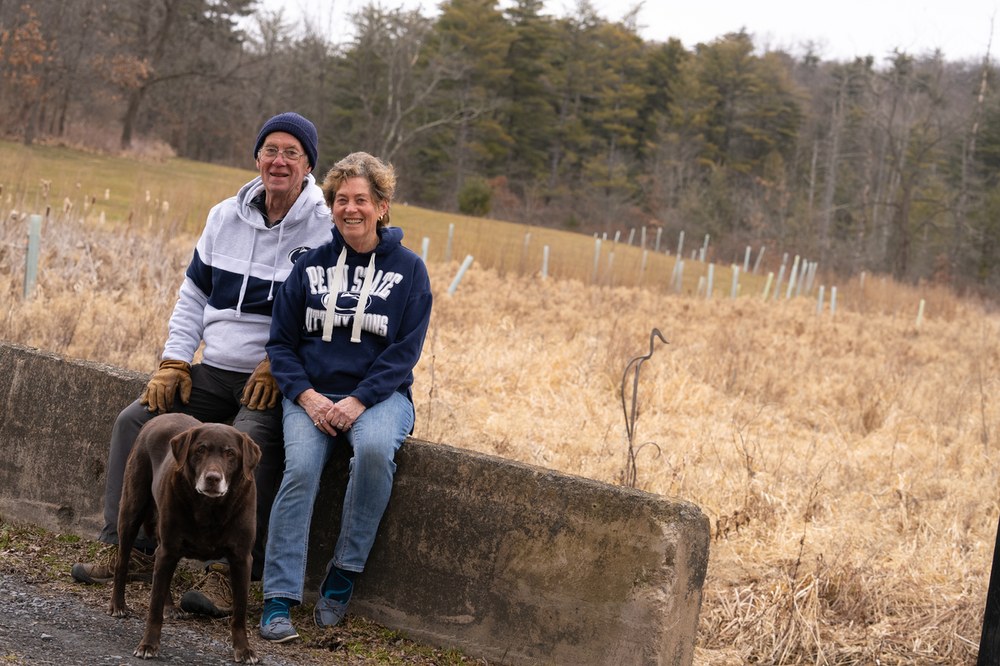
John and Marion Sheridan at home on their Huntingdon County farm. Photo credit: Michael Houtz
In the summer of 2018, torrential rains caused flash flooding in central and eastern Pennsylvania. Homes were destroyed, interstate highways shut down and, on a 150-acre farm in Huntingdon County, the Beaver Branch stream surged over its banks.
"It's this small, intermittent stream, which doesn't even have water in it for long stretches of the summer, and water was pouring out over it," said Marion Sheridan, who has lived on the farm for more than 40 years. "We'd never seen anything like that before."
Marion and her husband, John Sheridan, both Penn State graduates, decided to contain the floodwaters using piles of old railroad stones that lined the streambed. Before starting, they made a call to the Centre County Conservation District.
"We said, 'Hey, we've got this pile of stones; can we please use them to contain this stream?' which at that point was flooding toward the house, the fields, even down near the road," John Sheridan said. "They said, 'No, you can't, but we can work with you,' and that's how all this started."
"All this" is now a fully operational row crop farm that also is an oasis for wildlife. The Sheridans have spent the last five years partnering with researchers from the College of Agricultural Sciences to turn their farmstead into a nature preserve and wildlife refuge along the banks of Beaver Branch in Pennsylvania Furnace. It's just one example of how college researchers are working with communities to rethink wild landscapes and reimagine what nature looks like in the face of a changing climate.
"Penn State has been with us every step of the way," Marion Sheridan said. "The more improvements we make, the more we learn about the environment, about the property, about taking this little slice of our world and making it better for everyone else."
One of the first improvements on the property was the installation of a 2-acre streamside buffer to help manage high waters. The Sheridans partnered with the ClearWater Conservancy, the Centre County Conservation District and Penn State to plant nearly 2,000 trees and shrubs along the riparian buffer.
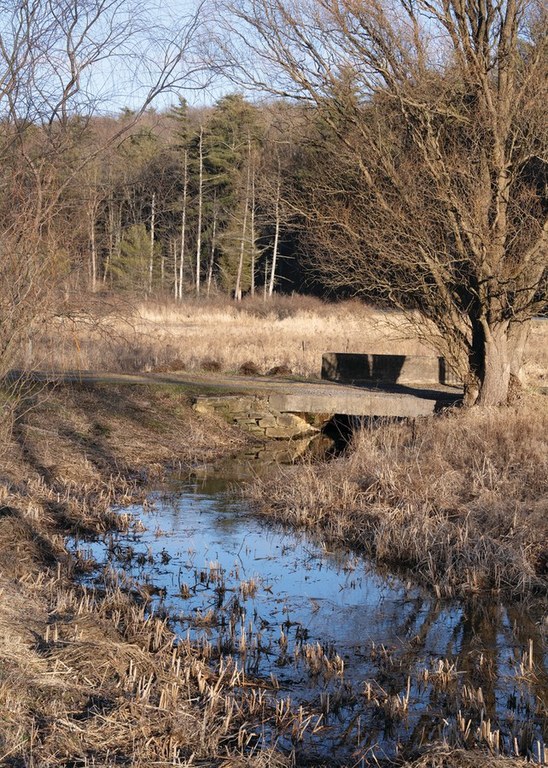
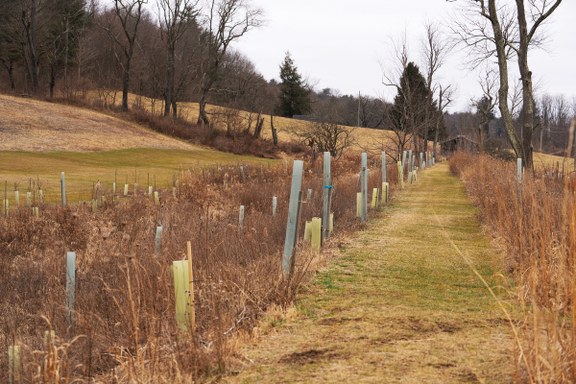
Working with researchers in the college, John and Marion Sheridan converted their land into a sanctuary for wildlife. Photos: Michael Houtz
"It's using a natural strategy such as woods, a forest buffer, to help protect water quality and deter flooding," said Tyler Groh, assistant research professor in the Department of Ecosystem Science and Management. He explained that in agricultural areas, buffers intercept sediment, nutrients, pesticides and other chemicals of environmental concern. The buffer slows down the surface runoff and ultimately reduces the amount of harmful material that gets into waterways.
Groh is part of a team of college researchers that was awarded a three-year, $750,000 grant from the U.S. Department of Agriculture's National Institute of Food and Agriculture to evaluate the effectiveness of riparian buffers to improve water quality throughout the state.
"Eventually, the buffer will also become wild habitat," he added. "It doesn't look wild to begin with because you plant in straight rows. But after about 10 to 15 years of management, it will become its own healthy ecosystem, and you can see nature take its course."
The Sheridans also are working with extension experts to preserve about 75 acres of forest and 4 acres of wetlands on their property, all while continuing to use their fields to farm corn, soybeans and green beans.
Since starting their plan to nurture the landscape five years ago, the Sheridans said the stream no longer floods, and the property has become a haven for wildlife. Their stream now hosts great blue herons, snowy egrets, red-winged blackbirds, American kestrels, red-tailed hawks and eastern box turtles, even the occasional bald eagle and marsh hawk.
"John and I are in our 70s, so obviously, we're not going to live long enough to see all the trees we've planted reach maturity," Marion Sheridan said. "So, this is an act of hope, a nod to the intelligence, energy and excitement we see in the young people who will blaze the way forward."
Connecting to landowners
The Sheridans are part of a demographic that is vital for conservation. According to the USDA, 60% of the nation's land is privately owned, and virtually all farmland is under private ownership. Any large-scale effort to preserve and protect natural landscapes will have to include private landowners, but historically there has been a lack of resources for making critical connections between landowners and conservationists, explained Jennifer Fetter, director of Penn State's Center for Agricultural Conservation Assistance Training.
"The thing that's missing from a lot of federal and nonprofit funding sources, up until now, has been money for people," said Fetter, who also serves as Penn State Extension water resources program leader. "The funding is typically for practices, but the projects don't install themselves, they don't design themselves, they don't engineer themselves, they don't inspect themselves, they don't maintain themselves, and they definitely don't knock on the farmers' doors and convince themselves to exist. Practices alone are not enough, so our center is here to play a critical role in the people side of the equation."
The College of Agricultural Sciences launched the center this past year as part of an ongoing effort to promote soil and water conservation on farms — and to connect Pennsylvania farmers, agricultural landowners and conservation professionals. The center is operated in partnership with the Pennsylvania State Conservation Commission and the USDA's Natural Resources Conservation Service.
The goal, Fetter explained, is to make a measurable impact throughout the state by leveraging funding and partnerships to ensure the health of land and water in Pennsylvania communities. The center will deliver conservation training and technical assistance to meet demand from farmers and forest landowners who are interested in addressing natural resource concerns such as water quality and soil loss, but also want to work their land productively.
"We are helping professionals and producers increase their knowledge base to be more proficient, have more skills and know what they need to get these practices on the ground," Fetter said. "We also can hire outside engineers to come in and help support these practices, and we are working on future workforce development, providing new undergraduate opportunities, internships and summer work experiences. These are hands-on experiences, so students are prepared when they enter the workforce."
Fetter pointed out that the center is designed to serve producers and conservation professionals alike by offering a wide variety of training and support. Like Penn State Extension, the center's team will be spread across Pennsylvania for easy access to all parts of the commonwealth. She explained that this will allow team members to conduct site visits, provide on-the-job training, and assist farmers and conservation professionals throughout the state.
"We're teaching empathy, training our environmentally minded young professionals to be ag literate and understand the pressures farmers face," Fetter said. "We're here to connect people in meaningful ways — and the health of our environment is at stake, so it's important to do it right."
Protecting wildness
When it comes to stakes, Deah Lieurance knows firsthand how bad it can get. Now an assistant professor of invasive species biology and management at Penn State, Lieurance recently joined the college from the University of Florida, where she conducted the first statewide evaluation of threats from invasive species.
Because Florida's climate is so hospitable, invasive species wreak havoc there more than anywhere else in the continental United States, Lieurance noted. Burmese pythons swim through the Everglades, feral hogs tear up forests, toxic cane toads hop through backyards, and venomous lionfish glide by beaches.
As a biosecurity expert, Lieurance explained that nature has now reached the point where it is so altered by human behavior that "wild" landscapes need to be managed if they are going to survive.
"We need to start rethinking and redefining some of these things that we have in our mind as 'a natural landscape,'" she said. "Nothing is untouched by human hands, whether that's directly through the introduction of non-native species or indirectly through climate change. Nature is so broken that it must be managed, and we need a collective, concerted effort to do that."
Lieurance is now working with Gov. Josh Shapiro's invasive species council to identify possible threats in Pennsylvania. She is assisting the state in risk assessment and analysis to stop invasions before they happen. She said one of her most important tasks is to help forecast threats from invasive species due to climate change.
"Right now, we have species that have been in the environment for years, and they don't do anything," Lieurance said. "But our climate is rapidly changing, so it might be 10 or 25 years from now, but at some point, these species will hit their sweet spot. They will have the right conditions, whether that's the temperature, changes in precipitation or carbon in the atmosphere, and suddenly they're going to become a serious problem. We call those sleeper species."
Lieurance is partnering with the U.S. Geological Survey to conduct a first-of-its-kind study to understand the pathways invasive species take when they spread to new habitats.
"I'm building a framework to manage secondary spreads," she said. "You have the initial introduction of a species that becomes invasive, but there is this secondary spread of the species along manmade pathways such as railcars, cargo ships and freight trucks. Our goal is to identify and rank those secondary pathways and develop a framework or screening tool to manage those pathways. We're no longer looking at individual species but analyzing entire networks of spread."
Lieurance explained that when she is doing her job right, nothing happens. It's the challenge of any public servant specializing in disaster mitigation and prevention. She said the most rewarding aspect of her work is teaching others to see the threats posed by invasive species and develop their own love for wild spaces; it's why her faculty research position is split 60/40 with Penn State Extension.
"I find that engaging the public, just through education, helps people make better decisions about how they interact with and use species in daily life," Lieurance said. "If I can help the average homeowner go to a garden center and make responsible purchases for their landscape, then I feel like I am making a contribution."
A new definition for wildness
A rapidly changing climate presents urgent challenges for wildlife and their ecosystems. That's why Jason Keagy is part of a team of Penn State scientists pioneering an innovative approach to understanding and defining nature. It's called landscape transcriptomics.
Keagy, an assistant research professor of wildlife behavioral ecology, explained that landscape transcriptomics examines how patterns of gene expression in living organisms relate to changes in their environment. The new field looks to genetics to better understand how habitat, weather, climate and contaminants affect wild creatures and to predict the subsequent effects on the function of wild plants and animals.
A transcriptome represents all RNA, or ribonucleic acid — molecules that play a crucial role in the transfer of genetic information — that are expressed from the genes of an organism, he said. By looking at finer-scale gene expression differences over larger-scale environments, trends emerge that offer new insight into how life on Earth is adapting to change, he added.
"We can literally read the RNA letters to find out which genes are active and how active they are," Keagy said. "We can then ask: How is the active part of the DNA code affected by an environmental stressor? That's where the landscape part comes in. Typically, we would do experiments to answer this question. But some things just can't be studied well in the lab. Nature is messy, and understanding that messiness is important."
One potential future scenario, he said, would be that a technician conducting an electrofishing survey for the Pennsylvania Fish and Boat Commission could take a small piece of gill, put it in a provided vial to preserve it, and mail it to Penn State.
"We would be able to tell the commission whether that fish was exhibiting signs of thermal stress or other stressors for which we had information," Keagy said.
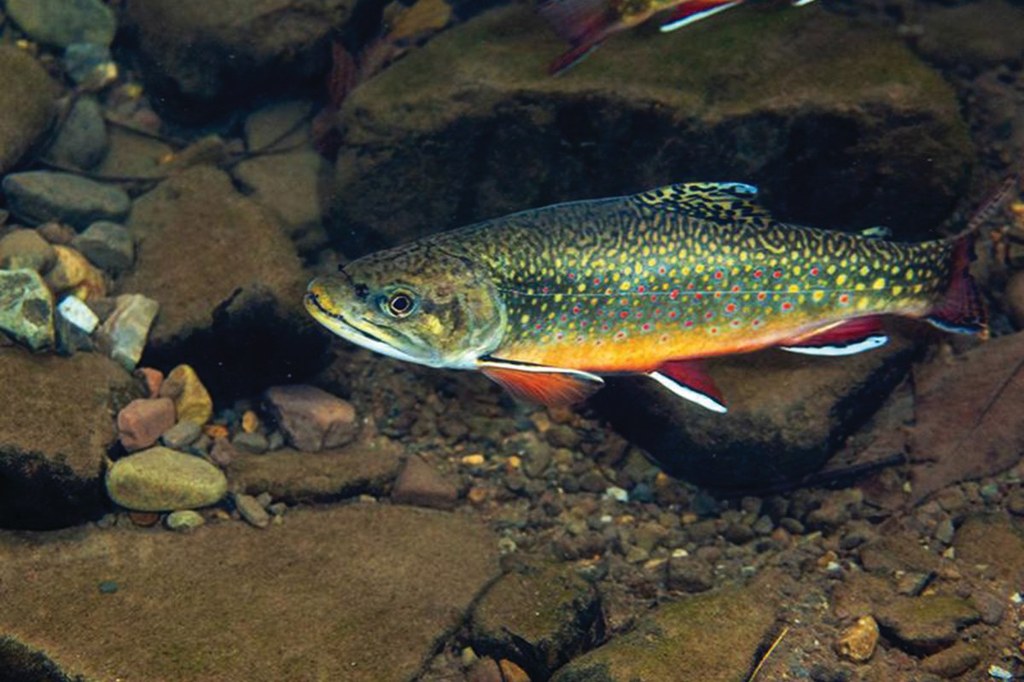
Under a potential future scenario using landscape transcriptomics, a technician conducting an electro-fishing survey of brook trout for the Pennsylvania Fish and Boat Commission could take a small piece of gill, put it in a provided vial to preserve it, and mail to Penn State. University researchers would be able to tell the commission whether that fish was exhibiting signs of thermal stress. Photo: Ryan Hagerty, U.S. Fish and Wildlife Service
The landscape transcriptomics initiative at Penn State recently received a Strategic Networks and Initiatives Program grant from the college. The team includes Christina Grozinger, Publius Vergilius Maro Professor of Entomology; Heather Hines, associate professor of biology and entomology; and Tyler Wagner, assistant unit leader of the U.S. Geological Survey's Pennsylvania Cooperative Fish and Wildlife Research Unit and adjunct professor of fisheries ecology.
"Penn State is uniquely positioned to advance this emerging field," said Blair Siegfried, the college's associate dean for research. "The college has a particular strength in taking a holistic, interdisciplinary approach to solving the crises our planet faces."
Conservation genetics
Julian Avery, associate research professor of wildlife conservation, is part of a team of Penn State scientists using genetic analysis to learn how species are adapting to changes in the environment.
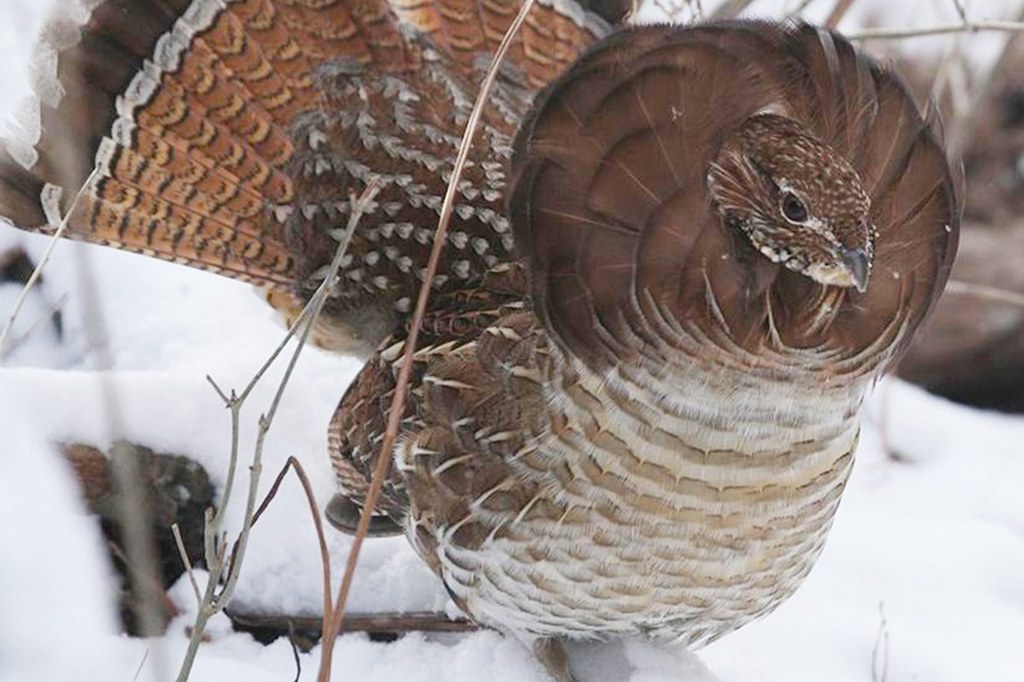
A genetic analysis of ruffed grouse reveals that Pennsylvania's state bird harbors more genetic diversity and connectivity than expected. Photo: H. Korber/Pennsylvania Game Commission
He recently co-authored a study of Pennsylvania's ruffed grouse populations, which have declined by up to 70% since the early 1960s. The research team sequenced individual bird genomes from habitats that either were fragmented by human development or still were intact. They found that the ruffed grouse has more genetic diversity and its populations are more connected than expected, meaning Pennsylvania's state bird is better off genetically than previously thought.
"By all typical metrics, the ruffed grouse is in a state of rapid decline," Avery said. "Yet, until now, no one had used genetic tools to investigate the effects of this decline at a deeper level. This means that habitat protection and other management interventions can work to protect this species and help preserve the genetic diversity that still exists."
But not all species have the flexibility to adapt to changes in their environment such as birds that are more mobile, Avery explained. Climate change and human development move at a faster pace than evolution, and many animals no longer can keep up. He has now focused his research on one of nature's slowest and most at-risk animals: terrestrial turtles.
Avery is leading a project to understand how forest management has influenced surface temperatures and how those temperatures affect reptile populations, specifically box turtles and wood turtles, the latter of which are close to receiving federal protection under the Endangered Species Act, he explained.
"Turtles, in general, are long-lived," Avery said. "They don't reach maturity and start producing offspring until they are much older. So, they may come into a habitat that is hospitable to them when they are young, but by the time they're breeding at later points in life, they're occupying a totally different environment."
He added that migration is off the table for turtles, unlike bird species that can travel to friendlier environments. That means turtles are especially reliant on humans to ensure that forests provide the right kinds of nesting habitats and thermal resources for an organism that gets a lot of its energy from the sun.
"We're carving up the landscape at such a rate that we are constantly putting threatened turtles in closer proximity to roads and urban infrastructure, and we are increasing access for nest predators such as skunks and raccoons that disrupt their nesting habitats," Avery said. "It's always the organisms that are late to mature and slowest to reproduce that suffer most from disturbances to their environment."
Avery has made it his personal and professional mission to get more people out into nature and show them the effects of human development and climate change on wildlife. He makes a point of teaching field classes every semester and reaching as many students as possible to "convert" more people into caring for nature.
"It has become super apparent to me that we must find a way to share the natural world with others," Avery said. "Nobody has the internal capacity to conceptualize what you're saying about global change until they've seen it, been a part of the environment in a way that they can experience what you are talking about, so they are no longer just thinking about animals as their cat or dog, but they are learning to love the little creatures that nobody sees hiding under the leaf litter."
Arguably one of the most important and elusive leaf-litter creatures is the salamander, an amphibian that is the research focus of David Miller, associate professor of wildlife population ecology.
"The salamander is actually quite common, but most people have never seen one," Miller said. "In fact, if you measured the weight of salamanders in a Northeastern forest, they would have more biomass than white-tailed deer. We just never see them because they spend most of the time underground, but they have a vital role in the forest."
He explained that salamanders are part of the forest nutrient cycle. They help develop soil layers by eating insects and invertebrates, which are digested and deposited as nutrients into the leaf litter. They also are an important source of food for other animals.
The fact that salamanders are excellent at hiding makes them hard to track, so Miller is leading a new National Science Foundation-sponsored project to monitor them in forests throughout the Northeast. A network of biologists will partner with recent college graduates to monitor salamander populations in 25 study areas across the northeastern U.S. The goal is to build the next generation of ecologically driven biologists while collecting essential information on how climate change is affecting amphibians and other animals in the forest.
"We follow the individual salamanders through time in these study areas to understand how climate specifically is affecting their demography," Miller said.
Amphibians, which use the environment around them to regulate their body temperature, are particularly sensitive to changes in the climate, Miller explained. Over the past few decades, novel pathogens and diseases also have taken a dramatic toll on the world's amphibians.
Miller is leading a local, NSF-funded project to examine the connection between climate change and seasonal outbreaks of a dangerous amphibian pathogen called chytrid fungus.
"We're working to understand how climate regulates this pathogen and what role temperature plays in its ability to spread," Miller said. "We have to study climate impacts on multiple fronts, including disease dynamics, because we'll need to predict where and when outbreaks will happen in the future."
By Adrienne Berard
Features
Breaking the Silence on Farm Stress
Farming has always been a demanding profession, but today's farmers face unprecedented pressures that can severely impact their mental health.
Biting Back
Research Targets Vector-Borne Diseases to Save Lives
Leading Forward
Ott brings deep connection to role of dean.


